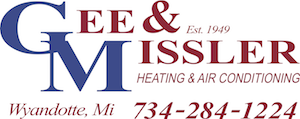
You shouldn’t have to sacrifice comfort or drain your wallet to keep your home at a pleasant temperature during the summer.
But what is the right temperature, exactly? We go over ideas from energy experts so you can choose the best temp for your residence.
Here’s what we suggest for the most energy-efficient setting for air conditioning in Wyandotte.
Recommended Thermostat Settings for Summer
Most people find using the thermostat at 72-73 degrees provides ideal comfort. However, if there’s a big difference between your inside and outside warmth, your AC expenses will be higher.
This is our advice based on the U.S. Department of Energy (DOE) and ENERGY STAR®.
While at home: 78 degrees. While that sounds hot, there are approaches you can keep your home pleasant without having the air conditioning going frequently.
Keeping windows and blinds closed during the day keeps cool air where it should be—within your home. Some window coverings, including honeycomb shades or plantation shutters, are made to provide added insulation and enhanced energy conservation.
If you have ceiling fans in your residence, the DOE says you can raise thermostat settings about 4 degrees higher without giving up comfort. That’s since they cool through a windchill effect. Because they cool people, not spaces, shut them off when you move from a room.
If 78 degrees still feels too uncomfortable at first glance, try doing a test for about a week. Start by upping your temperature to 78 degrees while you’re at your house. Then, progressively turn it down while using the tips above. You could be shocked at how cool you feel at a warmer temperature setting.
While away: 88 degrees. There’s no reason to keep the air conditioner working all day while your residence is vacant. Moving the temperature 7–10 degrees higher can save you as much as 5–15% on your electrical expenses, according to the DOE.
When you come home, don’t be tempted to put your thermostat under 78 to cool your residence more quickly. This isn’t useful and usually results in a more expensive electrical expense.
A programmable thermostat is a useful way to keep your temperature controlled, but it requires setting programs. If you don’t utilize programs, you risk forgetting to increase the set temperature when you go.
If you want a hassle-free resolution, think about installing a smart thermostat. This thermostat links with your phone, so it is aware when you’re at your house and when you’re gone. Then it intuitively adjusts temperature settings for maximum savings. How much exactly? Usually $180 each year on heating and cooling, according to ENERGY STAR.
Another perk of having a smart thermostat? You can use your phone to keep an eye on and change temperature settings from nearly anywhere.
While sleeping: Around 70 degrees. While ENERGY STAR advises 82 degrees, that might be unpleasant for the majority of families. Most people sleep better when their sleeping area is chilly, so that’s why the National Sleep Foundation suggests 60–67 degrees. But that might be too cold, based on your pajama and blanket preference.
We recommend using a comparable test over a week, setting your temperature higher and progressively decreasing it to choose the best setting for your house. On cool nights, you could learn keeping windows open at night and relying on a ceiling fan is a preferable solution than operating the AC.
More Ways to Save Energy This Summer
There are other approaches you can spend less money on utility bills throughout warm weather.
- Buy an energy-efficient AC system. Central air conditioners only last about 12–15 years and become less efficient as they age. An upgraded air conditioner can keep your residence comfier while keeping electrical expenses low.
- Set yearly air conditioner tune-ups. Regular air conditioner maintenance keeps your system operating properly and may help it operate at greater efficiency. It can also help prolong its life expectancy, since it allows techs to spot little problems before they cause a major meltdown.
- Put in new air filters regularly. Use manufacturer instructions for replacing your air filter. A clogged filter can result in your system short cycling, or switch on and off too much, and drive up your electrical.
- Inspect attic insulation levels. Just about 90% of residences in the U.S. don’t have enough insulation, according to the Insulation Institute. The majority of southern climates should have 13–14” of attic insulation, while northern climates require 16–18”.
- Have your ductwork inspected. Ductwork that has loosened over time can leak cold air into your attic, walls or crawl space. This can result in huge comfort issues in your home, such as hot and cold spots.
- Seal openings, doors and windows. Keep humid air in its place by plugging cracks. You can also caulk or weather strip doors to seal more cold air indoors.
Use Less Energy This Summer with Gee & Missler Heating & Air Conditioning
If you need to conserve more energy during hot weather, our Gee & Missler Heating & Air Conditioning specialists can provide assistance. Reach us at 734-284-1224 or contact us online for additional details about our energy-saving cooling products.


